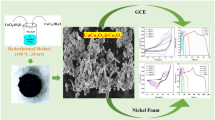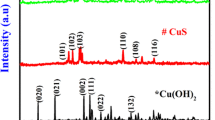Abstract
In this study, we developed a transition metal oxide based CuO/Co3O4 nanocomposites (NCs) by a facile hydrothermal method and the synthesized samples have been used as electroactive material for supercapacitor applications. The as-synthesized CuO/Co3O4 NCs were characterized by various techniques such as XRD, FESEM, XPS, etc. FESEM shows the uniform morphology of CuO/Co3O4 (1:3) NCs. Powder XRD confirms the formation of CuO/Co3O4 NCs without any impurities. XPS revealed the chemical state of metallic species. The electrochemical properties studied by CV, GCD and EIS analysis, confirms the pseudocapacitive behaviour with high specific capacitance at low scan rate. The FESEM image of CuO/Co3O4 NCs shows mixture of two different morphologies, spherical and cubical. These specific morphologies provide more active sites for electrochemical redox reactions. For comparison, CuO/Co3O4 NCs with different molar ratios were prepared and electrochemical properties were also analysed. The synergistic effect between metal oxides has enhanced the specific capacity of the nanocomposite. Electrochemical investigation of the synthesized samples and the influence of the molar ratios of CuO to Co3O4 in the composites were examined. The electrode of CuO/Co3O4 NCs exhibited high specific capacitance of 860 F/g at a current density of 2 A/g, which is higher than the previous reports in hydrothermal method. These results highlighted that the outstanding electrochemical performance of CuO/Co3O4 NCs, can be considered as a promising electrode material for electrochemical energy storage supercapacitors.









Similar content being viewed by others
Data availability
The authors do not have permission to share data.
References
Y. Zhou, H. Qi, J. Yang, Z. Bo, F. Huang, M.S. Islam, X. Lu, L. Dai, R. Amal, C.H. Wang, Z. Han, Two-birds-one-stone: multifunctional supercapacitors beyond traditional energy storage. Energy Environ. Sci. 14, 1854–1896 (2021). https://doi.org/10.1039/D0EE03167D
D. Zhao, H. Liu, X. Wu, Bi-interface induced multi-active MCo2O4@MCo2S4@PPy (M = ni, zn) sandwich structure for energy storage and electrocatalysis. Nano Energy 57, 363–370 (2019). https://doi.org/10.1016/j.nanoen.2018.12.066
S. Jayasubramaniyan, S. Balasundari, S.J. Yeom, N. Naresh, T. Rani, E.V. Rapaka, N. Satyanarayana, H.W. Lee, P. Muralidharan, Synthesis of porous CuCo2O4 nanorods/reduced graphene oxide composites via a facile microwave hydrothermal method for high performance hybrid supercapacitor applications. Electrochim. Acta 390, 138865 (2021). https://doi.org/10.1016/j.electacta.2021.138865
H.J. Kim, S.Y. Kim, L.J. Lim, A.E. Reddy, C.V.V.M. Gopi, Facile one-step synthesis of a composite CuO/Co3O4 electrode material on ni foam for flexible supercapacitor applications. New J. Chem. 41, 5493–5497 (2017). https://doi.org/10.1039/C7NJ01109A
S. Zhang, Z. Hu, K. Liu, Y. Liu, H.E. Fang, Q. **e, Synthesis and characterization of porous cobalt oxide/copper oxide nanoplate as novel electrode material for supercapacitors. Trans. Nonferr. Metals Soc. 25, 4054–4062 (2015). https://doi.org/10.1016/S1003-6326(15)64055-9
S.R. Patade, D.D. Andhare, S.B. Somvanshi, S.A. Jadhav, M.V. Khedkar, K.M. Jadhav, Self-heating evaluation of superparamagnetic MnFe2O4 nanoparticles for magnetic fluid hyperthermia application towards cancer treatment. Ceram. Int. 46, 25576–25583 (2020). https://doi.org/10.1016/j.ceramint.2020.07.029
H. Wang, C. Quing, J. Guo, A.A. Aref, D. Sun, B. Wang, Y. Tang, Highly conductive carbon–CoO hybrid nanostructure arrays with enhanced electrochemical performance for asymmetric supercapacitors. J. Mater. Chem. A 2, 11776–11783 (2014). https://doi.org/10.1039/C4TA01132E
A. Tahira, Z.H. Ibupto, M. Willander, O. Nur, Advanced Co3O4–CuO nano-composite based electrocatalyst for efficient hydrogen evolution reaction in alkaline media. Int. J. Hydrog Energy. 44, 26148–26157 (2019). https://doi.org/10.1016/j.ijhydene.2019.08.120
S. Balasundari, S. Jayasubramaniyan, P. Thangavel, M. Vithiya, T. Rani, P.A. Rayjada, N. Satyanarayana, P. Muralidharan, Heterostructure CuO/Co3O4 nanocomposite: an efficient electrode for supercapacitor and electrocatalyst for oxygen evolution reaction applications. ACS Appl. Eng. Mater. 1, 606–615 (2023). https://doi.org/10.1021/acsaenm.2c00146
Z.L. Goh, N.M. Saidi, N.K. Farhana, S. Bashir, J. Iqbal, K. Ramesh, S. Ramesh, S. Wageh, A. Kalam, Sonochemically synthesized cobalt oxide nanoparticles as an additive for natural polymer iodide electrolyte based dye-sensitized solar cells, sustain. Energy Technol. Asses. 49, 101746 (2022). https://doi.org/10.1016/j.seta.2021.101746
C.V.V.M. Gopi, R. Vinodh, S. Sambasivam, I.M. Obaidat, R.M.N. Klla, H.J. Kim, One-pot synthesis of copper oxide–cobalt oxide core–shell nanocactus-like hetrostructures as binder free electrode materials for high-rate hybrid supercapacitors. Mater. Today Energy 14, 100358 (2019). https://doi.org/10.1016/j.mtener.2019.100358
S. Prabhu, S. Sohila, D. Navaneethan, S. Harish, M. Navaneethan, R. Ramesh, Three dimensional flower-like CuO/Co3O4/r-GO heterostructure for high-performance asymmetric supercapacitors. J. Alloys Compd. 846, 156439 (2020). https://doi.org/10.1016/j.jallcom.2020.156439
H. Ju, X.D. Liu, C.Y. Tao, F. Yang, X.L. Liu, X. Luo, L. Zhang, A novel edge-rich structure of CuO/Co3O4 derived from prussian blue analogue as a high-rate and ultra-stable electrode for efficient capacitive storage. Electrochim. Acta 366, 137410 (2021). https://doi.org/10.1016/j.electacta.2020.137410
M. Chatterjee, S. Sain, A. Roy, S. Das, S.K. Pradhan, Enhanced electrochemical properties of Co3O4 with morphological hierarchy for energy storage application: a comparative study with different electrolytes. J. Phys. Chem. Solids 148, 109733 (2021). https://doi.org/10.1016/j.jpcs.2020.109733
M. Marzouki, R. Zarrougui, O. Ghodbane, Effect of surfactant structure on charge storage properties in Co3O4–based electrodes. J. Electroanal. Chem. 823, 121–127 (2018). https://doi.org/10.1016/j.jelechem.2018.05.040
K. Wang, B. Lv, H. Wu, X. Luo, J. Xu, Z. Geng, Soft-template-synthesis of hollow CuO/Co3O4 composites for pseudo-capacitive electrode: a synergetic effect on electrochemical performance. J. Solid State Chem. 244, 75–83 (2016). https://doi.org/10.1016/j.jssc.2016.09.006
C. **, Y. Cui, G. Zhang, W. Luo, Y. Liu, Y. Sun, Z. Tian, W. Zheng, Synthesis of copper-cobalt hybrid oxide microflowers as electrode material for supercapacitors. Chem. Eng. J. 343, 331–339 (2018). https://doi.org/10.1016/j.cej.2018.02.117
R. Hu, Z. Feng, B. Gao, G. Liu, X. Wang, Y. Meng, X. Song, Z. Tan, Three-dimensional binder-free electrodes with high loading of electroactive material for high performance asymmetric supercapacitors. J. Electroanal. Chem. 927, 116988 (2022). https://doi.org/10.1016/j.jelechem.2022.116988
Acknowledgements
The authors would like to express special thanks of gratitude to Centralised instrumentation and service laboratory, Annamalai university for providing their lab facilities.
Funding
The authors have not disclosed any funding.
Author information
Authors and Affiliations
Contributions
KA: Conceptualization, Methodology, Writing—original draft. SD: Supervision, Writing—review & editing, SS: Data curation, Visualization. MA: Review & editing.
Corresponding authors
Ethics declarations
Completing interest
The authors declare that they have no known completing financial interests or personal relationships that could have appeared to influence the work reported in this paper.
Additional information
Publisher’s Note
Springer Nature remains neutral with regard to jurisdictional claims in published maps and institutional affiliations.
Rights and permissions
Springer Nature or its licensor (e.g. a society or other partner) holds exclusive rights to this article under a publishing agreement with the author(s) or other rightsholder(s); author self-archiving of the accepted manuscript version of this article is solely governed by the terms of such publishing agreement and applicable law.
About this article
Cite this article
Athira, K., Dhanapandian, S., Suthakaran, S. et al. Facile hydrothermally grown CuO/Co3O4 nanocomposite as an effective electrode material for enhanced supercapacitor applications. J Mater Sci: Mater Electron 35, 268 (2024). https://doi.org/10.1007/s10854-024-12022-8
Received:
Accepted:
Published:
DOI: https://doi.org/10.1007/s10854-024-12022-8




